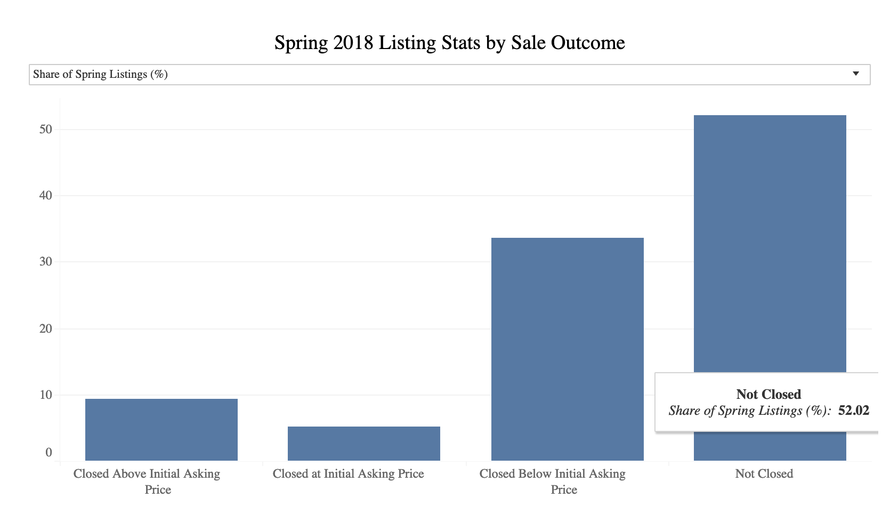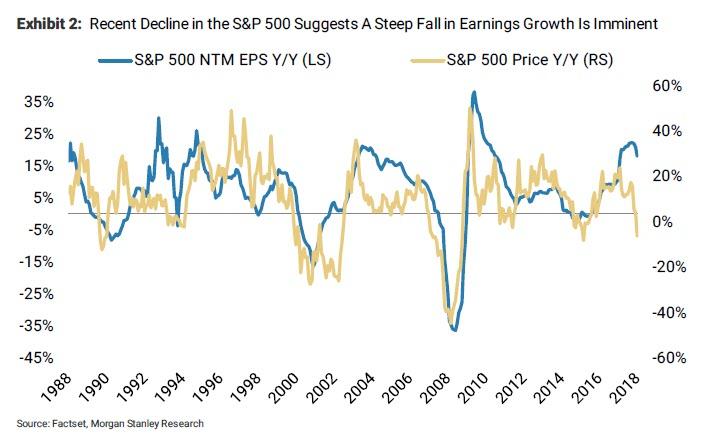Authored by Dagny Taggart via The Organic Prepper blog,
An infectious disease expert has warned that a deadly disease found in deer could infect humans in the near future.

Often referred to as “zombie deer” disease because of the symptoms, Chronic Wasting Disease (CWD) has been reported in at least 24 states in the continental United States and in two provinces in Canada as of January 2019.
But is this warning too late? Because there is an extremely similar disease that has already killed quite a few people.
And before we get further into this – some of you are already thinking that the government is trying to “scare” us. Others will say that the government is trying to “cover it up.” But rationally, neither of these is true. It took a lot of digging to find the information and piece it all together, however, all the information is readily available on the CDC website.
Minnesota has issued a warning.
Michael Osterholm, director of the Center for Infectious Disease Research and Policy at the University of Minnesota, recently told lawmakers that CWD should be treated as a public health issue.
That unsettling news surfaced at a hearing Thursday at the Minnesota Capitol, where a number of experts from the University of Minnesota pressed upon lawmakers that the disease should be treated as a public health issue — a major expansion of its current scope as mostly a wildlife and hunting concern.
The issue is especially pressing for Minnesota, where wildlife officials are tracking the state’s largest outbreak of CWD yet in deer in the southeast portion of the state. (source)
Osterholm (who sat on a panel of experts tracking the emergence of mad cow disease, or BSE, decades ago) issued this warning during the hearing:
“It is my best professional judgment based on my public health experience and the risk of BSE transmission to humans in the 1980s and 1990s and my extensive review and evaluation of laboratory research studies … that it is probable that human cases of CWD associated with the consumption of contaminated meat will be documented in the years ahead. It is possible that number of human cases will be substantial and will not be isolated events.” (source)
While he is aware that skeptics will accuse him of fear-mongering, Osterholm said, “If Stephen King could write an infectious disease novel, he would write about prions like this.”
There is a very similar disease that has already killed people.
He noted that for years, many public health and beef industry experts did not believe a similar disease – bovine spongiform encephalopathy (BSE, also known as “mad cow disease” – could infect people. In 1996, researchers found strong evidence that BSE can infect humans as a variant known as Creutzfeldt-Jakob disease (vCJD).
Since 1996, more than 230 vCJD cases have been identified in 12 countries, 178 of them in the United Kingdom, 27 in France, and four in the United States. Just last fall, a case of mad cow disease was confirmed in Scotland, reports Food Safety News.
Also important to note: Hunters in Kentucky contracted a version of spongiform encephalopathy from squirrels in the 1990s.
Here’s what you need to know about “zombie deer” disease.
CWD is a transmissible spongiform encephalopathy disease found in deer, elk, moose, reindeer, and caribou. It is a progressive disease that always kills its victims.
The disease is believed to be caused by abnormal proteins called prions, which are thought to cause damage to other normal prion proteins that can be found in tissues throughout the body. They are most often found in the brain and spinal cord, leading to brain damage and development of prion diseases. Infected brain cells eventually burst, leaving behind microscopic empty spaces in the brain matter that give it a “spongy” look.
Prions are misfolded proteins that are somehow infectious (we’re still not really sure how or why) and for which we have no treatments or cures. If you were to catch one, you’d basically deteriorate over the course of several months, possibly losing the ability to speak or move, and eventually you would die. Doctors wouldn’t be able to do anything to save you. (source)
The disease is believed to spread through saliva, urine, or feces from live deer or through contact with high-risk parts such as the backbone, eyes, or spleen of harvested deer. The disease can spread through the natural movement of deer but it spreads farther and quicker when humans move the deer.
Symptoms develop slowly – sometimes taking years to appear – and include stumbling, lack of coordination, drooling, lack of fear of people, and aggression.
So far, CWD has been reported in 24 states, and the number of cases is increasing.
According to the Centers for Disease Control and Prevention (CDC), CWD was first identified in captive deer in the late 1960s in Colorado and in wild deer in 1981. By the 1990s, it had been reported in surrounding areas in northern Colorado and southern Wyoming. Since 2000, the area known to be affected by CWD has increased to at least 24 states, including states in the Midwest, Southwest, and limited areas on the East Coast.
The CDC notes that it is possible CWD is occurring in other regions, but that cases have not been detected yet because some areas do not have strong animal surveillance systems.
As of January 2019, there were 251 counties in 24 states with reported CWD in free-ranging cervids. This map from the CDC is based on the best-available information from multiple sources, including state wildlife agencies and the United States Geological Survey (USGS). For a full list of states and counties with reported cases, please click here.

(source)
Yesterday it was reported that the Virginia Department of Game and Inland Fisheries has found CWD in 26 deer in Northwest Virginia and two in Shenandoah County. They said 26 of the CWD-positive deer were harvested by hunters and showed no symptoms of the disease.
So you can’t depend on the fact that a deer doesn’t “look” sick.
Creutzfeldt-Jakob disease appears to have already killed several people in the past.
CJD has killed several people and in the cases mentioned below, the victims consumed venison and their cases progressed rapidly.
According to a report from Popular Science:
In the 1990s, three deer hunters contracted Creutzfeldt-Jakob (known as CJD or vCJD when referring to the variant caught from infected meat) when they were less than 30 years old, which raised concern, because these diseases typically take years to develop and people aren’t often diagnosed when they’re young. (source)
In a 2004 report titled Chronic Wasting Disease and Potential Transmission to Humans, the CDC described the three cases referenced above. Here is a summary of each.
Case 1 involved a 25-year-old man who reportedly died of a prion disease. He rarely hunted, but his grandfather hunted deer and elk throughout much of the 1980s and 1990s and regularly shared the venison with the family. He primarily hunted in southeastern Wyoming, around the known CWD-endemic area. “It remains unknown whether the possible exposure of the case-patient to CWD-infected venison potentially contributed to the early onset of his prion disease,” according to the CDC.
Cases 2 and 3 involved two men with CJD who were 26 and 28 years of age. They grew up in adjacent counties and became ill within several months of each other. In the first case, autopsy samples confirmed a CJD diagnosis. According to the report (which, again, was written in 2004), “The patient may have occasionally eaten venison originating from the Upper Peninsula of Michigan while away from home during his college years. However, ongoing surveillance has not detected CWD in Michigan deer.” In the second case, autopsy confirmed a prion disease diagnosis. “The patient did not hunt but may have eaten venison from Michigan once when he was 1–2 years old,” says the report.
The report from Popular Science referred to additional cases:
In the early 2000s, several more patients turned up with CJD and then several more with vague neurological symptoms that resembled prion diseases. Three men in particular all ate together at regular wild game feasts. (source)
The CDC report includes details about those cases.
Two CJD cases with a “positive history of exposure to venison obtained from the known CWD-endemic areas” are discussed. One of the patients was a 61-year-old woman who grew up in an area where this disease is known to be endemic. She ate venison harvested locally, and her autopsy confirmed CJD. The second patient was a 66-year-old man who was reported to have eaten venison from two deer harvested in a CWD-endemic area. Both of the deer he consumed tested negative for CWD, and his autopsy details were not provided.
Three cases from 2003 are also mentioned. Three men (ages 54, 63, and 66) from the same area died of CJD. They had “striking neuropathologic similarities”. The report states that “their illness may represent a new entity in the spectrum of prion disease”.
In a report titled Fatal Degenerative Neurologic Illnesses in Men Who Participated in Wild Game Feasts — Wisconsin, 2002, the CDC described the cases of the men referenced in the Popular Science report.
Case 1 involved a 66-year-old man from Wisconsin. He was a lifelong hunter who ate venison frequently. He hunted primarily in northern Wisconsin, but also at least once in Montana. He died in February 1993. The autopsy indicated subacute spongiform encephalopathy, compatible with CJD.
He hosted wild game feasts at his cabin in northern Wisconsin from 1976 until shortly before his death.
Case 2 involved a 55-year-old man from Minnesota. He was not a hunter but had a history of eating venison. He made an estimated 12 visits to the cabin where the wild game feasts referred to in Case 1 were held, but he participated in only one feast during the mid-1980s. He died in July 1999, and the autopsy demonstrated widespread subcortical spongiform lesions, consistent with CJD.
Case 3 involved a 65-year-old man from Wisconsin who died in August 1993. He had a history of eating venison and participated regularly in wild game feasts held at the cabin owned by the man referenced in Case 1. He was a lifelong hunter and hunted mostly in Wisconsin, but also in Wyoming and British Columbia. The autopsy showed symmetrical frontal lobe cerebral cortical atrophy and mild temporal lobe atrophy, but no evidence of CJD.
There are alarming geographic links between the deer cases and the human cases.
In states where deer are infected with CWD, there have been more cases of CJD in humans. And the fact that mad cow disease was passed to humans who ate the infected beef has caused the CDC to pay attention.
Wisconsin, Montana, and Wyoming are all states that now have known cases of CWD in deer.
According to a January 2019 report from the government of British Columbia, “The disease is widespread in the Canadian prairies and is moving west toward the B.C. border. The B.C. Wildlife Health Program has been monitoring for CWD since 2002 and has yet to find an infected animal in this province.”
The CDC report also includes alarming details about cases in Colorado and Wyoming (emphasis mine):
Despite the decades-long endemicity of CWD in Colorado and Wyoming, the incidence of CJD and the age distribution of CJD case-patients in these two states are similar to those seen in other parts of the United States. From 1979 to 2000, 67 CJD cases from Colorado and 7 from Wyoming were reported to the national multiple cause-of-death database. (source)
Here are is an excerpt from the 2004 CDC report conclusion:
The lack of evidence of a link between CWD transmission and unusual cases of CJD, despite several epidemiologic investigations, and the absence of an increase in CJD incidence in Colorado and Wyoming suggest that the risk, if any, of transmission of CWD to humans is low.
Although the in vitro studies indicating inefficient conversion of human prion protein by CWD-associated prions raise the possibility of low-level transmission of CWD to humans, no human cases of prion disease with strong evidence of a link with CWD have been identified. However, the transmission of BSE to humans and the resulting vCJD indicate that, provided sufficient exposure, the species barrier may not completely protect humans from animal prion diseases.
Because CWD has occurred in a limited geographic area for decades, an adequate number of people may not have been exposed to the CWD agent to result in a clinically recognizable human disease. The level and frequency of human exposure to the CWD agent may increase with the spread of CWD in the United States.
Because the number of studies seeking evidence for CWD transmission to humans is limited, more epidemiologic and laboratory studies should be conducted to monitor the possibility of such transmissions. (source)
CWD is extremely contagious
A 2017 study titled Chronic wasting disease: Emerging prions and their potential risk states that “CWD is one of the most contagious prion diseases”.
Here are a few excerpts from that study.
As the geographic distribution and case numbers of CWD are constantly growing, exposure of humans to CWD prions becomes more likely. To date, bovine spongiform encephalopathy is the only example of interspecies transmission of prion disease to humans. The potential zoonotic transmission of CWD is an alarming issue and still an open question.
Laboratory studies suggest that the risk of CWD transmission to humans is low.
These findings suggest a notable species barrier between cervids and humans; however, prion diseases are dynamic; interspecies passage of CWD can result in prion adaptation to new host species. Besides, the existence of more than one CWD strain may contribute to higher heterogeneity in disease and transmission profiles.
Although the evidence gathered so far is in favor of a low risk to transmit CWD to humans, results from in vitro studies indicated that the species barrier is not absolute. (source)
A report from Food Safety News titled ‘Surprising’ Discovery Made About Chronic Wasting Diseaseexplains the alarming findings of a 2015 study:
According to researchers at The University of Texas Health Science Center at Houston (UTHealth), grass plants can bind, uptake and transport infectious prions. Why this is so important takes some understanding of what prions are.
Much smaller than bacteria, prions are single proteins that cannot be destroyed by typical “kill strategies” such as extreme heat or ultraviolet light.
“With prions, nothing like that works,” said Claudio Soto, Ph.D., a UTHealth researcher and lead author of an article about the topic published May 26, 2015, in Cell Reports.
These protein-based infectious agents cause the characteristic spongy degeneration of the brain, leading to emaciation, abnormal behavior, loss of bodily functions, and death. (source)
It gets passed through plants.
Some people reading this may think, “That’s it, I’m becoming a vegetarian.”
Not so fast. Plants aren’t safe either.
Soto’s team found, to summarize, that plants can act as a carrier of CWD because they can “uptake prions from contaminated soil and transport them to different parts of the plant”.
“Surprisingly, we found that they do bind to plants very efficiently,” Soto explained. “Even more surprisingly, plants infected with the prions were able to transmit the disease when animals were fed the contaminated plants.”
An infected animal can shed the disease a lot over a year (via urine and feces), and its decomposing body can further infect the soil and therefore the plants.
Soto warns that there is a good possibility that prions have been progressively accumulating in the environment.
“We have to be careful about the potential dangers of this,” he said. “We need to take precautions.” (source)
Getting rid of CWD is impossible.
Antibiotics do not kill CWD. Neither does cooking.
To give you an idea of just how persistent prions are: In 1985, the Colorado Division of Wildlife tried to eliminate CWD from a research facility by treating the soil with chlorine, removing the treated soil, and applying an additional chlorine treatment before letting the facility remain vacant for more than a year. Those efforts failed – they were unsuccessful in eliminating CWD from the facility.
In its conclusion, the 2004 CDC report states:
Because of the long incubation period associated with prion diseases, convincing negative results from epidemiologic and experimental laboratory studies would likely require years of follow-up. In the meantime, to minimize the risk for exposure to the CWD agent, hunters should consult with their state wildlife agencies to identify areas where CWD occurs and continue to follow advice provided by public health and wildlife agencies. (source)
Soto told Food Safety News he would agree.
He said that even though there have been no confirmed cases of infections in humans from CWD, the public should know that “it’s a possibility that needs to be explored.”
“I don’t want to scare people,” he said, “but these (CWD) prions are accumulating, and prions have a long incubation period — sometimes as long as 30 to 40 years in humans.” (source)
So with an incubation period like that, a person could be infected and not know it for decades.
How you can avoid infection with CWD prions
This doesn’t mean that you must completely avoid game, but you have to be careful.
The CDC offers some guidelines for hunters:
Hunters harvesting wild deer and elk from areas with reported CWD should check state wildlife and public health guidance to see whether testing of animals is recommended or required in a given state or region. In areas where CWD is known to be present, CDC recommends that hunters strongly consider having those animals tested before eating the meat. (source)
In addition, the agency advises hunters to avoid eating meat from deer and elk that look sick or test positive for CWD. They should wear gloves when field-dressing carcasses and minimize the handling of brain and spinal cord tissues. As a precaution, they should avoid eating deer and elk tissues known to harbor the CWD agent (e.g., brain, spinal cord, eyes, spleen, tonsils, lymph nodes) from areas where CWD has been identified.
In addition, hunters should wash their hands and instruments thoroughly after field dressing is completed. When taking the game to be processed, they should request that their animal is processed individually, without meat from other animals being added to the meat from their animal.
If hunters notice animals that are unusually thin and exhibit behavior such as having trouble walking, as well as those acting tame around humans and allowing someone to approach them, they should notify their state wildlife agency.
The CDC also states that “a negative test result does not guarantee that an individual animal is not infected with CWD, but it does make it considerably less likely and may reduce your risk of exposure to CWD.”
H/T to KS

via ZeroHedge News http://bit.ly/2SHzijK Tyler Durden















